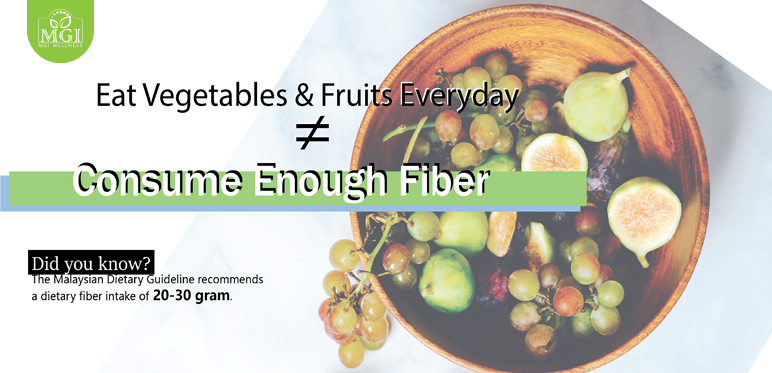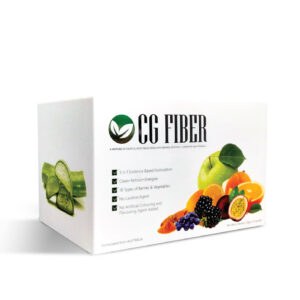Wellness
Why Dietary Fiber Is Good For You?
“Eat more fiber!” You have probably heard it before. But do you really know why fiber is so good for your health? Fiber is probably best known for its ability to prevent or relieve constipation. But eating foods high in dietary fiber can do so much more than keep you regular.
Dietary fiber, commonly known as fiber , is found in the whole foods we eat daily from vegetables, fruits, to legumes and grains. But why is fiber important for gut health, digestion, and our overall health?
What Is Fiber?
Fiber is a type of carbohydrate found naturally in whole plant-based foods that is not digestible in humans and acts like a broom that’s gently brushing out your intestines. Fiber is a vital part of diet promoting healthy digestion and other health benefits like lowers cholesterol levels, helps control blood sugar levels and helps maintain bowel health.(1)
Types of Fiber
There are 2 different types of fiber, both beneficial to health.
- Soluble fiber
Soluble fiber dissolves in water. It is fermented by bacteria as it moves through the digestive system. This type of fiber absorbs water and becomes gooey and gel-like consistency.(1) It can help lower cholesterol and slows digestion which can be beneficial for weight loss. Food with soluble fiber include oats, beans, lentils, apples, chia seeds and prunes.
- Insoluble fiber
Insoluble fiber does not dissolve in water and is left intact as food moves through the gastrointestinal tract and fermented by bacteria in the colon.(1) It promotes regular bowel movements by contributes to the bulk of the stool and speeds up the elimination of waste through the colon which provides benefit to those who struggle with constipation. Examples of insoluble fiber are leafy greens, cauliflower, nuts and berries.
Why Do We Need To Eat Fiber?
There are many health benefits to eating enough fiber, especially with our digestive system and gut health.
- Normalizes bowel movements and helps maintain bowel health.
Fiber increases the weight and size of your stool and softens it. A bulky stool is easier to pass, decreasing your chance of constipation. If you have loose, watery stools, fiber can help to solidify the stool as it absorbs water and adds bulk to stool. A high-fiber diet may lower your risk of developing hemorrhoids and lowers risk of colorectal cancer.(2) Research found that a 10% colon cancer risk reduction for every 10 g of total dietary fiber consumed daily.(3) This is because fiber naturally scrubs and promotes the elimination of toxins from gastrointestinal tract.
- Have Healthier Gut Bacteria.
Fiber with prebiotic effects feeds and nourishes the good bacteria that exist naturally in the gut. It strengthen and significantly increase the good bacteria while suppressing the bad bacteria to promote an optimal environment for good digestive health.(3) Some fiber sources with prebiotic effects include garlic, onion, sweetcorn, beetroot, green peas, chickpeas, soybeans, banana, oats, apples and barley.
- Aids in achieving healthy weight.
High-fiber foods tend to be more filling than low-fiber foods, so you’re likely to eat less and stay full and satisfied longer. Moreover, high-fiber foods tend to take longer to eat and to be less “energy dense,” which means they have fewer calories for the same volume of food.
- Lowers cholesterol levels.
Think of fiber like a sponge. Soluble fiber found in oats, beans, barley and flaxseed has been linked to lower levels of LDL (“bad”) cholesterol. Soluble fiber has absorbent properties, once inside the small intestine, the fiber attached to the circulating cholesterol and eliminating it from the body. Research shows that people who increase their soluble fiber intake by 5 to 10 grams daily have up to a 5% drop in LDL(“bad”) cholesterol.(4) For instance, half cup of oatmeal provides 3 to 4 grams of fiber. You can further top up the fiber by adding fruits like banana or berries.
- Helps control blood sugar levels.
We can think of fiber as a slow motion button for blood sugar spikes. Foods rich in fiber take longer time to digest, therefore blood sugar does not rise and fall dramatically like it does with refined carbohydrates. Besides, fiber also slows digestion and steadies blood sugar levels, which curbs sugar cravings and sustains energy.
How Much Fiber Do We Need?
The Malaysian Dietary Guideline recommends a dietary fiber intake of 20-30 gram a day. If you are eating at least two servings of fruits and three servings of vegetables and at least four servings of grain products per day (at least two of which are whole grains), you are likely meeting the dietary requirement.
However, according to The Ministry of Health Malaysia, only a sad 6% of adult Malaysians consume recommended amount of fiber in a day.
Tips For Adding More Fiber To Your Diet
Let’s try some easy and simple ideas below to boost your fiber intake today!
- Jump-start your day with high-fiber breakfast cereal. Opt for cereals with “whole grain,” “bran” or “fiber” in the name. Oatmeal is a good choice where you can top your oatmeal with berries, banana , nuts and seeds for a perfect tummy-warming breakfast.
- Switch to whole grains. Consume at least half of all grains as whole grains such as whole grain bread, brown rice, quinoa, whole grain barley or whole wheat pasta.
- Make a fruit salad as dessert. Just combine some of your favorite fruits and add a little yogurt as a dressing. You can mix in a few nuts and seeds for even more fiber.
- Eat whole fruits instead of just the juice. By consuming the whole fruit, we are getting much more fiber and all the vitamins and minerals. For example, a whole orange provides 3.7 grams of fiber while a glass of orange juice (200ml) provides just 0.6 grams of fiber.
- Swap Fresh Veggies for Your Chips. We tend to binge on chips while watching TV shows or during afternoon snacks. But chips are high low in fiber and high I fat. Thus, try to serve crunchy fresh veggies instead. Can try sliced cucumbers, carrot sticks, celery or cherry tomatoes with dipping like plain yogurt.
- Opt for high-fiber snack options. Can opt for a handful of roasted , unsalted nuts like walnuts, cashews and almonds. Whole-grain crackers, air-popped popcorn and chickpeas are all good choices too.
Start to increase fiber in your diet gradually over a few weeks to prevent bloating and gas. This allows the natural bacteria in your digestive system to adjust to the change. In addition, remember to drink plenty of water. Fiber works best when it absorbs water, making your stool soft and bulky.
References:
- What Is Fiber?https://www.livescience.com/51998-dietary-fiber.html
- Masrul Masrul, Ricvan Dana Nindrea. Dietary Fibre Protective against Colorectal Cancer Patients in Asia: A Meta-Analysis. Open Access Maced J Med Sci. 2019 May 31; 7(10): 1723–1727.
- Aune D, Chan DS, Lau R, et al. Dietary fibre, whole grains, and risk of colorectal cancer:Systematic review and doseresponse meta-analysis of prospective studies. BMJ. 2011;343:d6617
- Justin L Carlsonal . Health Effects and Sources of Prebiotic Dietary Fiber. Curr DevNutr. 2018 Mar; 2(3): nzy005.
- Prasanth Surampudial. Lipid Lowering with Soluble Dietary Fiber. Curr Atheroscler Rep. 2016 Dec;18(12):75.
- Survey: Only 6% of M’sians eat enough fruits, vegetables. http://www.freemalaysiatoday.com/category/nation/2016/12/07/survey-only-6-of-msianseat-enough-fruits-vegetables/.



Really appreciate you sharing this article post. Will read on…
Highly energetic blog, I liked that bit. Will there be
a part 2?
That is very interesting, You are an excessively skilled blogger. I have joined your feed and look ahead to seeking extra of your magnificent post. Also, I have shared your site in my social networks!